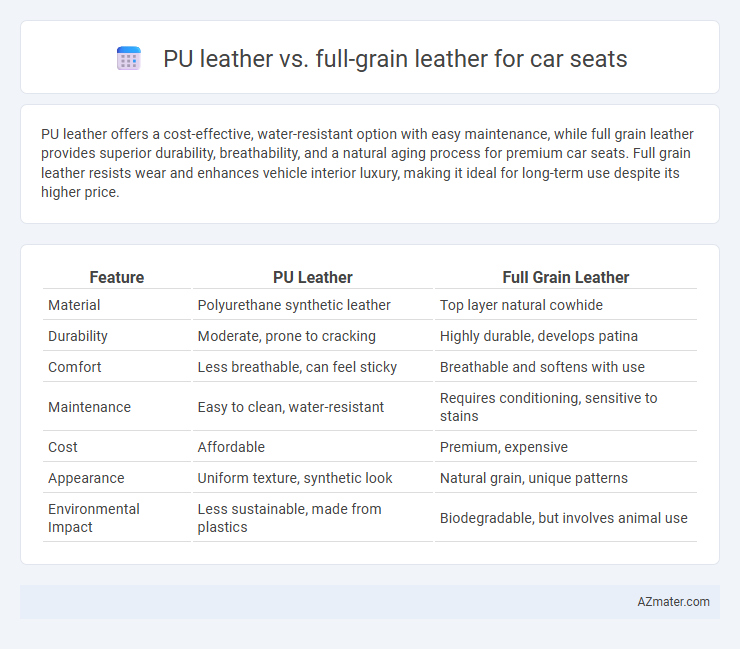PU leather offers a cost-effective, water-resistant option with easy maintenance, while full grain leather provides superior durability, breathability, and a natural aging process for premium car seats. Full grain leather resists wear and enhances vehicle interior luxury, making it ideal for long-term use despite its higher price.
Table of Comparison
| Feature | PU Leather | Full Grain Leather |
|---|---|---|
| Material | Polyurethane synthetic leather | Top layer natural cowhide |
| Durability | Moderate, prone to cracking | Highly durable, develops patina |
| Comfort | Less breathable, can feel sticky | Breathable and softens with use |
| Maintenance | Easy to clean, water-resistant | Requires conditioning, sensitive to stains |
| Cost | Affordable | Premium, expensive |
| Appearance | Uniform texture, synthetic look | Natural grain, unique patterns |
| Environmental Impact | Less sustainable, made from plastics | Biodegradable, but involves animal use |
Introduction to PU Leather and Full Grain Leather
PU leather, also known as polyurethane leather, is a synthetic material made by coating a fabric base with a flexible polymer, offering durability and water resistance at a lower cost. Full grain leather is derived from the top layer of animal hide, preserving natural grain and imperfections for superior strength, breathability, and a luxurious aging process. Car seats crafted from full grain leather provide enhanced comfort and longevity, while PU leather seats deliver an affordable, easy-to-maintain alternative with a consistent appearance.
Composition and Manufacturing Process
PU leather is a synthetic material made by coating a fabric base, typically polyester, with a flexible polyurethane layer, offering a uniform appearance and resistance to moisture. Full grain leather is crafted from the top layer of animal hide, maintaining natural grain patterns and durability, processed through tanning and finishing techniques that enhance breathability and strength. The manufacturing of PU leather involves chemical and mechanical processes to simulate genuine leather textures, whereas full grain leather undergoes organic treatments that preserve its natural characteristics.
Visual Appearance and Texture
PU leather offers a consistent and smooth appearance with a glossy finish that mimics genuine leather but can sometimes look artificial due to its uniform texture. Full grain leather features a natural, rich patina that develops over time, showcasing unique grain patterns and slight imperfections that enhance its premium look. The texture of full grain leather is supple and breathable, providing a more tactile and luxurious feel compared to the synthetic, slightly stiffer surface of PU leather.
Durability and Longevity
PU leather offers moderate durability for car seats but tends to wear out faster and is prone to cracking and peeling over time. Full grain leather provides superior longevity, maintaining strength and developing a patina that enhances its appearance with age. Its natural resistance to wear and tear makes full grain leather the preferred choice for long-lasting car seat upholstery.
Comfort and Breathability
PU leather offers a smooth surface with moderate comfort but lacks the breathability of full grain leather, which allows for better air circulation and temperature regulation in car seats. Full grain leather adapts to body temperature and becomes more comfortable over time thanks to its natural pores and fibers. This superior breathability prevents excessive sweating and enhances long-term seating comfort compared to the synthetic coating of PU leather.
Maintenance and Cleaning Requirements
PU leather car seats require regular wiping with a damp cloth and mild soap to maintain their appearance, as they are more prone to surface damage and peeling compared to full grain leather. Full grain leather demands periodic conditioning with specialized leather care products to prevent drying and cracking, ensuring long-term durability and a natural patina. Both materials benefit from prompt spill cleanup, but full grain leather generally withstands wear better with consistent maintenance.
Cost Comparison
PU leather for car seats typically costs between $15 and $30 per yard, making it a budget-friendly option compared to full grain leather, which ranges from $50 to $100 per square foot due to its premium quality and durability. The manufacturing process of PU leather is more economical, requiring synthetic materials that reduce production expenses, whereas full grain leather involves labor-intensive tanning and finishing techniques. Investing in full grain leather offers longer lifespan and natural breathability, but PU leather provides a cost-effective alternative with easier maintenance and water resistance.
Environmental Impact and Sustainability
PU leather, a synthetic alternative made from polyurethane, generally has a lower environmental footprint in terms of animal welfare but relies heavily on petrochemical resources and can contribute to microplastic pollution. Full grain leather, sourced from the top layer of animal hide, is biodegradable and offers durability which may reduce the frequency of replacement, yet its production involves higher water usage, chemical tanning processes, and methane emissions linked to livestock farming. Choosing between PU leather and full grain leather for car seats involves balancing synthetic material pollution against livestock environmental costs, highlighting the need for innovations in eco-friendly tanning and biodegradable synthetics.
Common Usage in Car Seats
PU leather is commonly used in car seats due to its affordability, water resistance, and ease of cleaning, making it a popular choice for budget-friendly and mid-range vehicles. Full grain leather, often found in luxury and high-end cars, offers superior durability, breathability, and natural texture, providing a premium feel and aging beautifully over time. Both materials cater to different consumer preferences, with PU leather excelling in cost-effectiveness and maintenance, while full grain leather represents luxury and longevity in automotive upholstery.
Which Leather is Best for Your Car Seats?
Full grain leather offers superior durability, natural breathability, and develops a unique patina over time, making it the best choice for car seats requiring longevity and premium feel. PU leather is more affordable, easier to clean, and resistant to stains but lacks the natural texture and breathability of full grain leather, leading to quicker wear in high-use environments. For car owners seeking luxury, comfort, and lasting quality, full grain leather is the optimal material for upholstery.

Infographic: PU leather vs Full grain leather for Car seat
 azmater.com
azmater.com